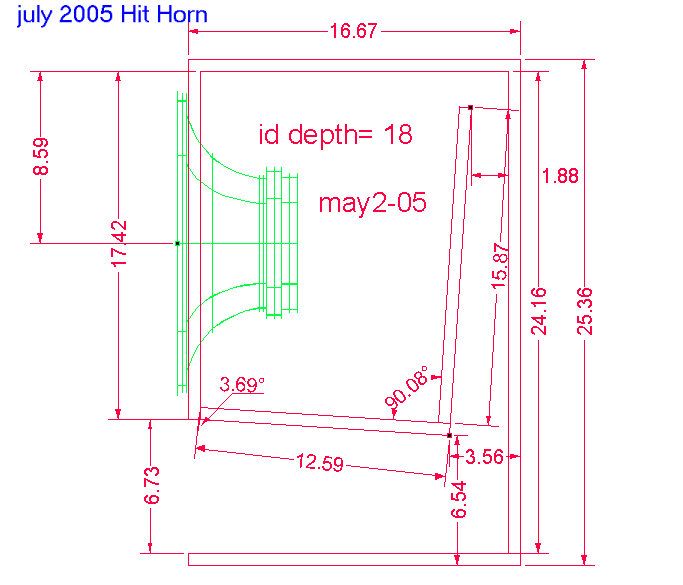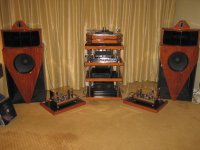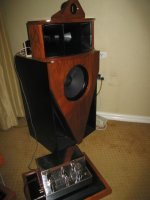I'd like to know what a K-coupler with front chamber ~like X15 but rear chamber the volume of K15 does with similar tuning to K15 - IIRC, X15 has around 1CF front chamber
X15 dimensions
http://img203.imageshack.us/img203/383/8zhe.jpg
http://img834.imageshack.us/img834/3350/cy87.jpg
So, you would like to see an AkAbak model of the X15 geometry which includes angled plates, but modified so that the rear chamber is like a K15? Or do you just want me to take the existing K15 model and adjust the front chamber to be circa 1 cubic ft like the X15? Building a new model of the X15 is a lot of work as the geometry is completely different and the drawings do not show all the critical dimensions - one would have to calculate them based on the ones shown. It would be helpful to have a plan with all widths of channels and heights of each section actually specified explicitly.
I don't why so many of the plans for the K-couplers I have seen, have all lacked the proper dimensional labels for the critical areas? The gap spacing between the shelves is often omitted, as well as the height of the vent gap. Those seem like critical dimensions and should be labeled. Maybe the drawings work fine for building the box, as the dimensions I need for a model fall out naturally once it is glued in place?
just the modified K15 model - even that's asking a lot of you. A test box would be best for Kenpeter's reflector system. I have a fully detailed fullsize blueprint dated 1955 for the first K12 aka "Karlsonette" which appeared in the fall of 1954. Good details of Karlson's K15 were published in the January 1954 issue of Radio and Television News. Within that article, Karlson warned against scaling K15 by 0.8. (I think it sounds and measures well - the front shelf might be made less deep for subjective experiments. Karlson's second K12 with the 10 degree distributive port panel was possibly introduced by 1957 and appeared as a construction article in the July 1958 issue of Popular Mechanics. I don't know if there were any articles for the K8. X15 was sold as a loaded system starting 1965 according to AUDIO magazine so didn't have published details to my limited knowledge. Karlson died January 1973.
just one view on the blue print - its like five feet by four feet in size
copyright
lower left quarter of the sheet - someone must have added color - I believe it was to avoid confusion
just one view on the blue print - its like five feet by four feet in size
copyright
An externally hosted image should be here but it was not working when we last tested it.
lower left quarter of the sheet - someone must have added color - I believe it was to avoid confusion
An externally hosted image should be here but it was not working when we last tested it.
Last edited:
look down in this old thread for some recent posts on a K12-size coupler built for synthesizer - electric piano use.
High Efficiency Speaker Asylum
High Efficiency Speaker Asylum
here's the July 1958 Popular Mechanics K12 plan with missing reference corrected by the late Gregg Baker
http://public.blu.livefilestore.com...Rzd63Mbmy-0jxqUvbpw/transductor-bo.jpg?psid=1
http://public.blu.livefilestore.com...Rzd63Mbmy-0jxqUvbpw/transductor-bo.jpg?psid=1
Eminence coaxials were and are good choices - I like the 80oz magnet cast frame Martin/Eminence 12cx (out of production) - an inexpensive PRV compression driver works well - the combo is more sensitive than 8" fullrange, lower distortion and much more headroom
An externally hosted image should be here but it was not working when we last tested it.
I have a pair of the poly cone version of the eminence cx2008 that I think would do better in the SK8 than the paper cone version would
http://www.eminence.com/pdf/acoustinator-cx2008.pdf
http://www.eminence.com/pdf/acoustinator-cx2008.pdf
yeah - the Acoustinator could be good for a little K-coupler - as a direct radiator, is it on the mellow/neutral side? which compression driver matches well? (ASD1001S-?)
I havent gotten a chance to try out different compression drivers with it. Ive been using a modified screw on piezo tweeter with it. The midrange is a bit forward but fairly mellow sounding for a guitar speaker
Yes its the Goldwood GT-400CD. I took them apart and doped the diaphragms with wet look. Right now I'm running the acoustinators without a crossover and the Goldwoods with a first order crossover crossed in at about 5khz.
the original K KN1142 could be rough - I think partly due to a bad phase plug design - I got one pretty smooth on a 5"x15" expo horn with a trap and ran it from a stepup transformer
does the Goldwood have smooth response down to a certain point and good highs? I'll have to grab a pair soon.
does the Goldwood have smooth response down to a certain point and good highs? I'll have to grab a pair soon.
I never bothered to measure them because they were originally were just to be used temporarily until I could get a compression driver. 2 years later I'm still using them. they sound fairly smooth to my ears. They have much less of that piezo hissss that the other piezo tweets I have in my pile of speakers
I am going back to the fundamentals and trying to design a speaker that has some of the characteristics of a Karlson. I am thinking of using a double chamber reflex (DCR) as a starting point to tune the fundamental frequency lower (into mid or high 30's Hz), then augmenting the bass port with a horn - like a BVR, except in this case a DCBVR. Then if that works, I will add a Karlson slot on the output horns to smooth the response. So far I can get the tuning down to the high 30's with a Betsy, the cabinet is quite a bit taller (45 in H x 15 in W x 18 in deep). Now to add horns will make it even bigger. I see that the Karlson is actually quite compact for what it can do. I am still having a tough time getting it to throw a flat 90 dB bass shelf out to 5 meters (that shelf starts flat at 1 m but collapses at 3 m). I think this is due to the fact that the direct radiator is not going through the slot. I think that has a big effect. Just saying that the K15 is indeed a special design which is why after all these years it has been tough to improve upon significantly.
RCA-fan (aka Bill Woods) had a BVR design, which he called a half-horn, designed to have some hit, resulting in a response rise in the mid/upper bass not unlike a Karlson.
I think the image is from freddi's imageshack.
I one had the idea of a "K-VOTT", basically your regular Karlson, but with an added bottom partition where a large vent would be situated and the front of the cone still firing within a koupler chamber. There might be a bit more low-end from such a design, with a bit more cone excursion though. Your above idea has me wondering about a DCR rear chamber, with one vent exiting into the koupler and one in the exterior air.
IG
An externally hosted image should be here but it was not working when we last tested it.
I think the image is from freddi's imageshack.
I one had the idea of a "K-VOTT", basically your regular Karlson, but with an added bottom partition where a large vent would be situated and the front of the cone still firing within a koupler chamber. There might be a bit more low-end from such a design, with a bit more cone excursion though. Your above idea has me wondering about a DCR rear chamber, with one vent exiting into the koupler and one in the exterior air.
IG
Last edited:
here's RCA-Fan's "hitbox" for a typical 15" speaker and meant to have "hit" which can be complimentary to cello and drums - - it would be interesting to see what could be done with dual chamber versions and hybrid with K-coupler. K15 is a tough cookie to beat - might not look like it on a graph but K15 power handling is awfully good. I need new "K10" couplers


Last edited:
my V-vent (fb ~41Hz) measured above has little kick compared to K15 (fb maybe 48)- the reflex goes "lower" but has double or more the cone excursion on drums. A Karlson in its range can do a lot of spl without much visible cone movement. Why do the larger Ks show a close mic null at the cone approximately 1/2 octave below Fb? My skinny K18 lacks much rise around 200 but seems to have a lot of power output.
are the sidebands from modulation distortion in reflex part of the reason why reflex can have poorly controlled cone excursion?
are the sidebands from modulation distortion in reflex part of the reason why reflex can have poorly controlled cone excursion?
Beta 15cx in a reflex the size of K15's rear chamber with fb ~ like that of K15 vs the same speaker in K15
An externally hosted image should be here but it was not working when we last tested it.
Wow. Some interesting work going on.
To me, the interesting thing about the Karlsons is their front loading. That appears to be where the feeling of effortlessness and power comes from. If I were "going back to fundamentals", I'd find a way to retain this. One approach would be to design a tapped horn, and modify the exit so that it's a K-slot instead of a rectangle.
The original DBR rear loading of the K15 is not really their strongest aspect anyway, though it does more or less work. (IMHO 😉)
To me, the interesting thing about the Karlsons is their front loading. That appears to be where the feeling of effortlessness and power comes from. If I were "going back to fundamentals", I'd find a way to retain this. One approach would be to design a tapped horn, and modify the exit so that it's a K-slot instead of a rectangle.
The original DBR rear loading of the K15 is not really their strongest aspect anyway, though it does more or less work. (IMHO 😉)
the first thing imo is to acknowledge that the Karlson enclosures are already excellent in many ways when used with appropriate fullrange driver and coaxial woofers before moving on to hybrid.
The little X15 with its internal slotted pipe tweeter is also great and allows one to equal or beat any coaxial. The K-tube alone is an excellent HF lens.
K12 with a good coax sounds like - uh - a good Karlson which is reminiscent of a larger front horn system but more cohesive and perhaps more expansive.
A K could be augmented with a good subwoofer. Carl often applies a transform eq to vented Ks.
I don't know if K15's rear chamber is divided tightly enough or not to be a real DBR as removal of the rear shelf might not modify things a lot other than raise fb a bit - one function of the rear shelf is alleged to help clean up the rear wave with the damping pad. Karlson thought in mysterious but cool ways 😀
it would be interesting to see what can be done by making longer path K-tapped-horn hybrid - any ideas?
what would it take in a mod to the simple pipe in this video to lessen the 3/4 wave dip?
http://www.youtube.com/watch?feature=player_embedded&v=UJTctkDPKpE#at=11
The little X15 with its internal slotted pipe tweeter is also great and allows one to equal or beat any coaxial. The K-tube alone is an excellent HF lens.
K12 with a good coax sounds like - uh - a good Karlson which is reminiscent of a larger front horn system but more cohesive and perhaps more expansive.
A K could be augmented with a good subwoofer. Carl often applies a transform eq to vented Ks.
I don't know if K15's rear chamber is divided tightly enough or not to be a real DBR as removal of the rear shelf might not modify things a lot other than raise fb a bit - one function of the rear shelf is alleged to help clean up the rear wave with the damping pad. Karlson thought in mysterious but cool ways 😀
it would be interesting to see what can be done by making longer path K-tapped-horn hybrid - any ideas?
what would it take in a mod to the simple pipe in this video to lessen the 3/4 wave dip?
http://www.youtube.com/watch?feature=player_embedded&v=UJTctkDPKpE#at=11
Last edited:
- Home
- Loudspeakers
- Full Range
- A Speaker that Kicks Butt in Large Spaces

